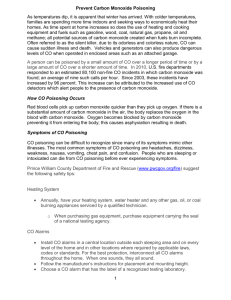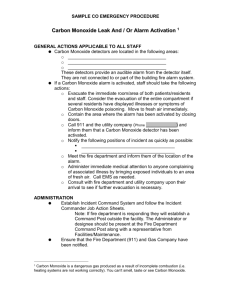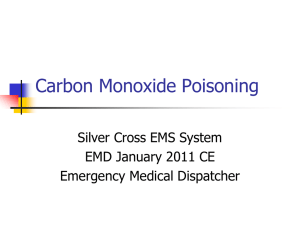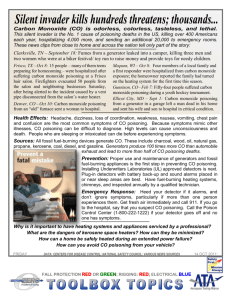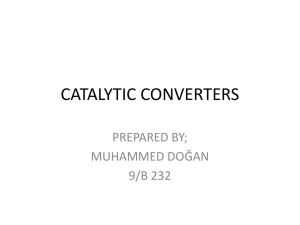Carbon Monoxide Safety
advertisement
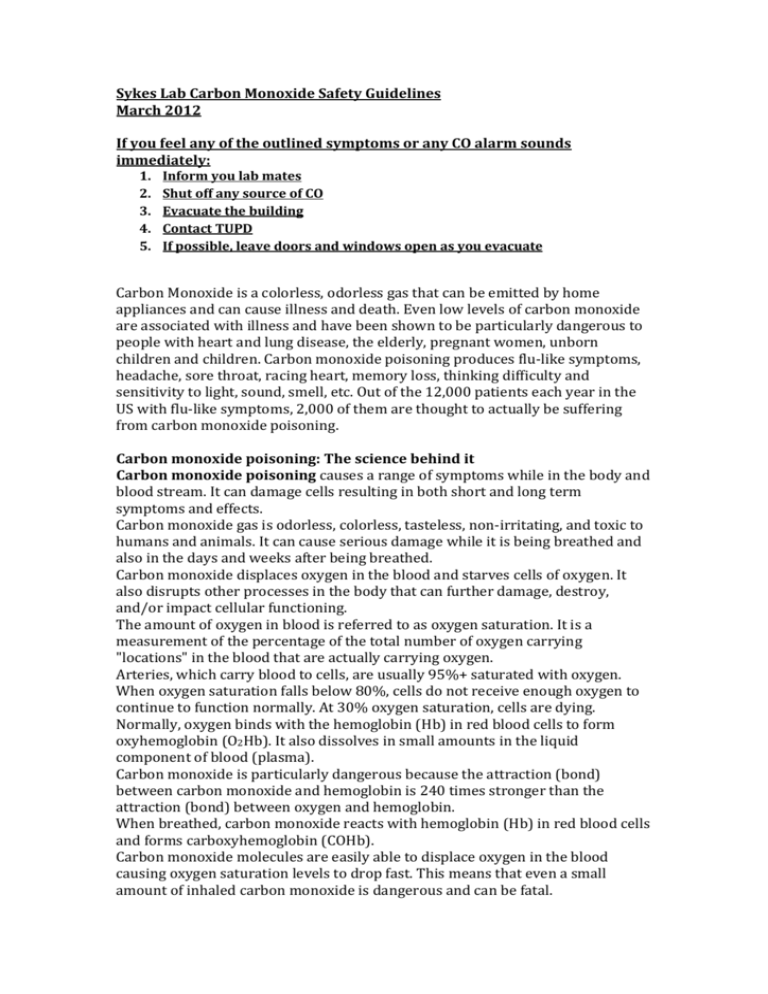
Sykes Lab Carbon Monoxide Safety Guidelines March 2012 If you feel any of the outlined symptoms or any CO alarm sounds immediately: 1. 2. 3. 4. 5. Inform you lab mates Shut off any source of CO Evacuate the building Contact TUPD If possible, leave doors and windows open as you evacuate Carbon Monoxide is a colorless, odorless gas that can be emitted by home appliances and can cause illness and death. Even low levels of carbon monoxide are associated with illness and have been shown to be particularly dangerous to people with heart and lung disease, the elderly, pregnant women, unborn children and children. Carbon monoxide poisoning produces flu-like symptoms, headache, sore throat, racing heart, memory loss, thinking difficulty and sensitivity to light, sound, smell, etc. Out of the 12,000 patients each year in the US with flu-like symptoms, 2,000 of them are thought to actually be suffering from carbon monoxide poisoning. Carbon monoxide poisoning: The science behind it Carbon monoxide poisoning causes a range of symptoms while in the body and blood stream. It can damage cells resulting in both short and long term symptoms and effects. Carbon monoxide gas is odorless, colorless, tasteless, non-irritating, and toxic to humans and animals. It can cause serious damage while it is being breathed and also in the days and weeks after being breathed. Carbon monoxide displaces oxygen in the blood and starves cells of oxygen. It also disrupts other processes in the body that can further damage, destroy, and/or impact cellular functioning. The amount of oxygen in blood is referred to as oxygen saturation. It is a measurement of the percentage of the total number of oxygen carrying "locations" in the blood that are actually carrying oxygen. Arteries, which carry blood to cells, are usually 95%+ saturated with oxygen. When oxygen saturation falls below 80%, cells do not receive enough oxygen to continue to function normally. At 30% oxygen saturation, cells are dying. Normally, oxygen binds with the hemoglobin (Hb) in red blood cells to form oxyhemoglobin (O2Hb). It also dissolves in small amounts in the liquid component of blood (plasma). Carbon monoxide is particularly dangerous because the attraction (bond) between carbon monoxide and hemoglobin is 240 times stronger than the attraction (bond) between oxygen and hemoglobin. When breathed, carbon monoxide reacts with hemoglobin (Hb) in red blood cells and forms carboxyhemoglobin (COHb). Carbon monoxide molecules are easily able to displace oxygen in the blood causing oxygen saturation levels to drop fast. This means that even a small amount of inhaled carbon monoxide is dangerous and can be fatal. Lack of oxygen can quickly result in damage affecting the brain, nervous system, heart, endocrine (regulatory) system, organ functioning, and can cause other damage. Even if normal oxygen (and saturation) is restored, damaged cells will continue to die over the next few minutes, hours, days and weeks. The brain does not regulate breathing based on the amount of oxygen in the blood. It regulates breathing based on levels of carbon dioxide (CO2) in the blood. A carbon monoxide poisoning victim can easily lose consciousness without realizing that anything is wrong because the brain is unable to recognize that oxygen levels are falling dangerously low. Carbon monoxide poisoning has biochemical effects that are more complex and serious than just oxygen deprivation alone. It also interferes with cellular functioning by attaching itself to myoglobin and cytochrome enzymes. Other areas of functioning are impacted and cause carbon monoxide poisoning: Disruption of a normal fixed ratio between oxygen, carbon monoxide and nitric oxide in the body Damage to blood vessels Damage to the nervous system Immune system responses during recovery In the weeks following exposure, damage to blood vessels and these other areas of functioning can then cause damage to myelin, an important protein that coats neurons. Myelin helps transmit signals more quickly within the nervous system and brain. The damage to brain cells triggers the immune system, which then responds by causing brain inflammation, which in turn causes [more] brain damage. This "biochemical domino effect" is what causes delayed symptoms and many of the long term symptoms and effects suffered by victims of carbon monoxide poisoning. The amount of damage caused by carbon monoxide poisoning depends on many factors including the levels of carbon monoxide in the air, the length of time it is breathed, the level of physical activity while exposed, age, pre-existing health conditions, and overall health. If exposed to elevated levels of carbon monoxide, any person or animal will develop symptoms as long as unsafe levels remain in the body/blood stream; however, people respond differently to the same level of exposure. The biochemical effects of carbon monoxide poisoning while in the body range from mild to severe in people with the same level of exposure. The ongoing symptoms and after effects can range from nothing to severe in people with the same level of exposure. Carbon monoxide PPM 0.2 9 10 30 35 70 150 200 400 800 1600 3200 6400 12,800 Time 8 hours 8 hours 1-4 hours 10-40 minutes 2-3 hours 1-2 hours 3 hours 45 minutes 2 hours 2-3hours 20 minutes 1 hour 5-10 Minutes 1 hour 1-2 minutes 25-30 minutes 1-3 minutes Result Natural level in air US EPA (TWA) outdoor limit Onset of recording Protech 8010 Lowest display for automatic readout detectors Maximum exposure allowed by OSHA Alarm sounds Alarm sounds Mild headache, fatigue, nausea, dizziness Serious carbon monoxide headache, other symptoms intensify Life threatening Dizziness, nausea, convulsions Unconscious Death Headache, dizziness, nausea Death Headache, dizziness, nausea Death Headache, dizziness, nausea Death Death Carbon monoxide is a flammable risk FLASH POINT: −191 °C LOWER FLAMMABLE LIMIT: >=12.5 % by volume UPPER FLAMMABLE LIMIT: 74 % by volume AUTOIGNITION: 600 °C Carbon monoxide will form an explosive mixture in air. Sources of CO in the Sykes lab. Leakage from gas-line. Ensure SNOOP is used when fitting any gas line. Ensure gas lines are not damaged Leakage from cylinder Place the cylinder in an area that avoids items dropping upon it. Ensure that the cylinder is attached to a solid object by gas straps at all times. (If there are no straps tell Colin, they will be sourced.) Ensure you have an understanding of all safety equipment in use in the lab. Manuals are available in the N-drive safety folder for all CO alarms. User/general lab info/lab safety/carbon monoxide When using CO, pay attention to CO alarms. The Protech 8010 models will display the current CO level at a lower level than the level, which causes alarms. Type and placement of CO alarms in the Sykes lab. Protech-8010 Automatic, continuous readout above 30 ppm Manually display current and peak levels from 10 to 500 ppm Mains powered only Tested weekly, records highest CO level over the week. Number 1 2 3 4 5 Location P001 Quiet Room P001 Sink/TPD Chamber P001 Near White Board P001A Near Fire Extinguisher P001A Fume hood First alert carbon monoxide alarm 1 2 Location P001 P001A Near fire extinguisher Mains powered with battery back-up Electrochemical carbon monoxide sensor Low battery warning and endof-life timer 5 year limited warranty Read out in PPM Kiddie Carbon Monoxide Alarm Located in the fume hood Battery powered
